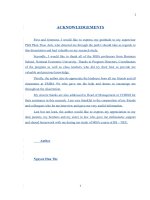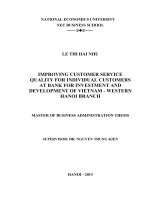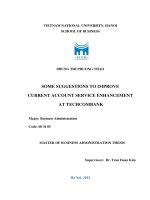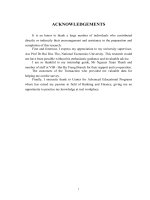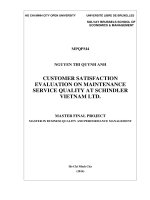IMPROVING CARD SERVICE QUALITY AT TECHCOMBANK
Bạn đang xem bản rút gọn của tài liệu. Xem và tải ngay bản đầy đủ của tài liệu tại đây (851.72 KB, 93 trang )
NATIONAL ECONOMICS UNIVERSITY
NEU BUSINESS SCHOOL
~~~~~~o0o~~~~~~
PHAM HONG TRANG
IMPROVING CARD SERVICE QUALITY AT TECHCOMBANK
MASTER OF BUSINESS ADMINISTRATION THESIS
HANOI – 2020
NATIONAL ECONOMICS UNIVERSITY
NEU BUSINESS SCHOOL
~~~~~~o0o~~~~~~
PHAM HONG TRANG
IMPROVING CARD SERVICE QUALITY AT TECHCOMBANK
MASTER OF BUSINESS ADMINISTRATION THESIS
SUPERVISOR: ASSOC.PROF.DR. VU THI MINH
HANOI – 2020
ACKNOWLEDGEMENT
First of all, I would like to thank to the Business School, National Economics
University (BSNEU) and all members, lecturers and assistants for their shared
knowledge and experience through many lectures, discussions and exams during
EMBA program.
Next, I would like to send my deepest and most sincere thanks to my
supervisor, Ph. D Tran Thi Minh Huong who spent a lot of time and enthusiasm
guiding research, helping me complete my graduation thesis.
I would like to sincerely thank the Board of Directors and colleagues at
MBS Hanoi Branch for their supporting in collecting information as well as data
related to the research topic and create the best conditions for me to complete
this graduation thesis.
I owe my loving thanks to my beloved family, without their encouragement,
support and understanding, it would be impossible for me to finish this work.
Although I have made many efforts to complete the thesis with all my
enthusiasm and abilities, but cannot avoid the shortcomings, I look forward to
receiving valuable contributions from supervisor, teachers, lectures of BSNEU and
all member of MBS Ha Noi branch.
Hanoi, October 2020
Nguyen Thi Minh Hang
TABLE OF CONTENTS
ACKNOWLEDGEMENT
4
ABBREVIATIONS
BPM
HR
HSX
HNX
IT
MBB
Business Project Management
Human Resources
Hochiminh Stock Exchange
Hanoi Stock Exchange
Information Technology
Military Commercial Joint Stock Bank
MBS
MO
PCS
MB Securities Joint Stock Company
M - Office
Personal Customer Service
5
LIST OF TABLES
Table 2.1 Model of Herzberg for the thesis..............................................................25
Table 3.1: Survey respondent structure............................................................................
Table 3.2 Analysis of Working conditions........................................................................
Table 3.3 Analysis of Company policies and administration............................................
Table 3.4 Analysis of Interpersonal relations...................................................................
Table 3.5 Analysis of Recognition for achievement.........................................................
Table 3.6 Analysis of Possibility of growth......................................................................
Table 3.7 Analysis of Employee motivation.....................................................................
6
LIST OF FIGURES
Figure 1.1: Research process...................................................................................10
Figure 2.1: Maslow’s Hierarchy of Needs........................................................................
Figure 2.2: Victor Vroom’s Expectancy Theory...............................................................
Figure 2.3: Herzberg’s Two Factor Theory.......................................................................
Figure 2.4: Adams’ Equity Theory...................................................................................
Figure 3.1: MBS organizational structure........................................................................
Figure 3.2: MBS Ha Noi Branch organizational structure................................................
Figure 3.3: Business performance of MBS Ha Noi Branch..............................................
Figure 3.4: Brokerage staff classified by age...................................................................
Figure 3.5: Brokerage staff classified by gender..............................................................
Figure 3.6: Brokerage staff classified by qualification.....................................................
Figure 3.7: Brokerage staff classified by seniority...........................................................
CHAPTER 1: INTRODUCTION
1.1 Rationale
In the developing economic situation nowaday, enterprises have a lot of
extremely strong competititors in the same industry in general and so do those
securities enterprises. The competition is not only focused on the quality of
products, services and information: one of the important factors helping to improve
the competitiveness of enterprises is Human Resources (HR from now on). HR
plays a decisive role in the success of the business. Beside that, enterprises that have
quality HR and make effective use of this resource will have a higher chance of
achieving success compared with other businesses in the same industry.
When employees are motivated to work, they will proactively research,
explore and continuously develop themselves to achieve higher levels of work
efficiency and with it, not only labour productivity but also improved work results.
Businesses will then be able to operate with lower costs and to improve their
competitiveness by gaining certain advantages in the industry. It can be said that
7
creating motivation for employees is very necessary and has very high practical
implications for businesses.
MB Securities Joint Stock Company (MBS) was founded in May 2000 by
the Military Commercial Joint Stock Bank (MB). This is one of the first six
securities companies in Vietnam. After long history of development, MBS has
become one of the biggest brokerage houses in Viet Nam. In 2009 and 2010, MBS
was the leader of market share on both Hanoi Stock Exchange (HNX) and HCM
Stock Exchange (HOSE) and has always been in the Top 5 of market share in the
market. Acknowledging that employee’s skills provide the strength for
competitiveness, MBS keeps striving to attract and the most talented staff in the
securities industry.
One of the important forces contributing to the operational efficiency of
MBS is the brokerage staff. This business unit brings significant revenues and
transaction fees, contributes to improve the market share and the company's position
in the market by finding investors and consulting them to trade in the stock market
and use financial services of MBS. In the current difficult conditions of the stock
market, it is necessary to create motivation for the brokerage team. Staff motivation
is one of the factors that directly affect the performance of brokers. If brokers are
motivated to work, they will intensify research, find and introduce securities
investment opportunities to customers, thereby increasing the transaction value and
profit for MBS. On the other hand, if the brokers do not have the motivation to
work, they will not be able to fulfil their own capacity, then delay in their work and
affect the development of the business.
Recognizing the importance of motivating brokers for the business
performance of the company, MBS has implemented many activities to motivate
labor and gradually create a friendly, cooperative working environment, promoting
the spirit of creative initiative of the staff, but through observation and monitoring
the work of the brokerage department at MBS, persisting limitations become
apparent. Therefore, the author would like to choose the topic "Employee
motivation of brokerage staffs at MB Securities Joint Stock Company- Ha Noi
8
Branch" as thesis with the desired results for this research paper to be useful
material for the leaders of the reference company and provide insights about
possible effective measures to enhance brokerage staff motivation.
1.2 Research objectives
The main purpose of this research is to understand Brokerage staff
motivation at MB Securities Joint Stock Company with the following basic
objectives:
- Synthesize the theoretical framework related to employee motivation;
- Analyse the current employee motivation for the brokerage staff of MBS
Ha Noi Branch to find out its strengths, weaknesses and the reason caused the
weaknesses;
- Propose recommendations to boost brokerage staff motivation at MBS.
1.3 Research questions
- What are the factors affect to employee motivation?
- What are the current motivation-enhancing work for the brokerage staff of
MBS? What are strengths, weaknesses and the reason caused the weaknesses?
- What should MBS do to enhance its brokerage staff motivation?
1.4 Research methodology
1.4.1 Research Process
The research process can be conducted as follow:
9
Figure 1.1: Research process
(Source: Researcher 2020)
1.4.2 Data collection method
Two sources of data collection were used:
Secondary Data
Secondary data was collected from the previous studies, textbooks, published
documents, research papers, articles on specialized journals, etc. Beside that, reports
and internal documents of MBS from 2017 – 2019 will be used.
10
Primary Data
Primary data was collected by in-depth interview and survey questionnaires.
+ In-depth interviews conducted with 3 sales managers and 3 ex - broker staffs in
MBS – Ha Noi Branch. Purpose of the interview: Understand what MBS has been
doing to motivate brokerage staffs and find the root cause of dissatisfaction
(Questions revolved around the factors that affect the motivation of employees
according to the theory applied in the thesis).
+ Survey questionnaires were sent to all brokers in MBS- Ha Noi Branch (82 people).
The number of respondents to the survey is 75 brokerage staff. All survey forms
collected are valid.
The survey consists of two parts:
-
Part A requested information including gender, age, education, years of working.
Part B contains five-point Likert-type scale items: Not satisfied at all (SD)=1, Not
satisfied (D)=2, Somewhat satisfied (U)=3, Satisfied (A)=4, and Very satisfied
(SA)=5. Respondents were asked to indicate and rate their perceptions about
employee motivation.
Survey questionnaires were sent to participate by email with both online and
offline format.
1.4.3 Data Analysis
The researcher will conducteda regression analysis. Secondary data was
summarized by text in tables. Primary data collected from survey wascollected and
analyzed by SPSS (Statistical Package for the Social Sciences).
1.5 Research scope
- Research object: This thesis focuses employee motivation of the brokers at
MBS - Hanoi branch.
- Location Scope: Research was conducted at Hanoi branch of MBS.
- Data collection time:
+ Secondary data: from 2017 to 2019
+ Primary data: 2020
1.6 Thesis structure
Apart from the acknowledgement, table of contents, executive summary,
11
conclusion, reference and appendixes, the main body of the study is divided into 4
chapters:
Chapter 1: Introduction
Chapter 2: Theoretical background of employee motivation
Chapter 3: Analysis of the current employee motivation of the brokerage
staff of MBS Ha Noi branch.
Chapter 4: Recommendations to enhance employee motivation of the
brokerage staff at MBS- Ha Noi branch
12
CHAPTER 2: THEORETICAL BACKGROUND OF
EMPLOYEE MOTIVATION IN THE ORGANIZATIONS
2.1 Overview of employee motivation in the organizations
Motivation has been studied for decades to figure out the cause of employee
actions, and what bring good results. Theories of motivation have been discussed,
challenged, and improved upon, in order to understand clearly about the human
condition (Boyett et al. 2000; Locke & Latham, 1990). No theory has been
shown to be better than all others theories, however, the knowledge based of
what motivates employees is constantly expanding, laying a stronger foundation
for the next theory of employee motivation (Kohn, 1987). Nelson (1999) wrote,
‘Employee motivation may represent one of the last frontiers for organizational
leverage’ (p. 265). In this case, it is important for managers, supervisors and
organizations to understand exactly what motivates their employees to perform
better to get the most out of them. By harnessing the hidden dynamics each
employee possesses, organizations can increase outcomes, innovate, and become
leaders in their industry instead of merely being.
2.1.1
Definitions of motivation
The term motivation is derived from the Latin word “movere” which means
“to move”. The definition of motivation in Cambridge dictionary is: “enthusiasm
for doing something”. An extended definition of motivation encompasses the idea
of promoting individual’s willingness to invest more efforts to achieve specific
objective:
Steers, R. (1984) define motivation as “that which energizes, directs, and
sustains human behaviour”.
Conroy (1994) has defined motivation as “a person’s active participation in
and commitment to achieving the prescribed results.”
Bartol and Martin (1998) define motivation as “a force that energizes
behaviour, gives direction to behaviour, and underlies the tendency to persist”.
13
Robbins and Coulter (2011): “motivation refers to the process by which a
person’s efforts are energized, directed, and sustained toward attaining a goal”.
In summary, this work will use the definition by Steers (1984): Motivation is
defined as that which energizes, directs, and sustains human behaviour. This
definition has three key elements: energy, direction, and persistence.
2.1.2
Employee motivation definition
Kanfer (1990) defines employee motivation as the psychological forces
within a person that determine the direction of that person’s behaviour in an
organization, effort level, and persistence in the face of obstacles.
The three key elements of Employee motivation:
- Direction of behaviour: Direction of behaviour refers to the behaviour
employees choose to perform from the many potential behaviours they could
perform.
- Level of efforts: How hard does a person work to perform a chosen
behaviour? It is not enough for an organization to motivate employees to perform
desired functional behaviours; the organization must also motivate them to work
hard at these behaviours.
- Levels of persistence: When faced with obstacles, roadblocks, and stone
walls, how hard does a person keep trying to perform a chosen behaviour
successfully?
2.1.3
The role of employee motivation in the organizations
Because motivation determines what employees do and how hard and
diligently they do it, people might think that an employee’s motivation to do a job is
the same as the employee’s job performance. In fact, motivation and performance
are two distinct aspects of behaviour in an organization. Performance is an
evaluation of the results of a person’s behaviour: It involves determining how well
or poorly a person has accomplished a task or done a job. Motivation is only one
factor among many that contributes to an employee’s job performance. It is possible
to identify the relation between motivation and performance: motivation is only one
14
of several factors that can affect performance; a high level of motivation does not
always result in a high level of performance. Conversely, high performance does not
necessarily imply that motivation is high: employees with low motivation may
perform at a high level if they have a great deal of ability.
2.2 Motivation theories
There are many theories of job satisfaction. Each of these theories take into
consideration one or more main determinants of job satisfaction (personality,
values, work situation and social influence) and specifies, more in detail, exactly
what causes one employee to be satisfied. In this work, the author discussed four of
the most popular theories: Maslow’s Hierarchy of Needs, Victor Vroom’s
Expectancy Theory, The Two-Factor Theory (Herzberg), Adam’s Equity Theory of
Motivation. These four theories approaches to job satisfaction are complementary.
Each theory helps to understand the various aspects of job satisfaction by
highlighting factors and issues managers need to consider in order to enhance the
satisfaction levels of their assistants.
2.2.1 Maslow’s Hierarchy of Needs
In 1954, Maslow first published “Motivation and Personality”, which
introduced his theory about how people satisfy various personal needs in the context
of their work. He postulated, based on his observations as a humanistic
psychologist, that there is a general pattern of needs recognition and satisfaction
that people follow in generally the same sequence. He also theorized that a person
could not recognize or pursue the next higher need in the hierarchy until her or his
currently recognized need was substantially or completely satisfied, a concept called
prepotency.
15
Figure 2.1: Maslow’s Hierarchy of Needs
Source: Jennifer M. George, Gareth R. Jones
•
Physiological needs: Of the five types of needs, physiological needs are at the
lowest level among human needs. These are the basic needs to sustain human life
such as the need to eat, sleep, stay, and heat. When these needs are not met to the
level necessary to sustain life, other human needs will not be able to further be
•
successfully fulfilled.
Safety needs: life safety is the most basic need, a premise for other contents such as
job stability, environmental safety, occupational safety.
• Social needs: social needs include the need for communication, the need for love,
closeness, appreciation, support, desire for inclusion, compassion, love, friendship,
affection.
• Esteem needs: a person's needs for internal factors such as self-esteem, self-control,
and performance as well as external factors such as status, recognition, and
attention.
• Self-actualization needs: a person’s need to grow, reach their potential and fulfill
16
themself; the drive to be what they can be.
According to Maslow: Satisfaction of the needs of individuals begins with
the most basic need, as only when the lower needs are satisfied, the new needs
appear. Managers who want to motivate their employees must first understand
where the employee is in the needs’ hierarchy, thereby orienting them to havethat
need fulfilled. Motivating policies achieve the highest results.
However, not all people are motivated by the same needs - any time different
people may be motivated by completely different factors. For example, an artist
may have a physiological deficiency, he still has a desire to be met with respect to
esteem, intellectual and aesthetic needs. Therefore, it is important to understand the
needs that are being pursued by each employee. To motivate employees, the
manager must be able to recognize the level of needs at which the employee is
active and use those needs as the level of motivation.
2.2.2 Victor Vroom’s Expectancy Theory
The Expectancy theory provides a sort of a mechanism for finding out
motivation through a certain type of calculation. Employees have personal goals that
they want to achieve and for this reason they work in organizations. These personal goals
can be accomplished with organizational reward or work results. Therefore, the
relationship between the organization's rewards or work results and personal goals is
very important, i.e. to what extent the organization's rewards meet the employee's
personal goals and to what extent the appeal of those rewards to employees. This
relationship can also be expressed in terms of the value that employees bring to work
results.
The Expectancy theory says that:
Effort or motivation = E x I x V
Among that:
•
•
Expectancy (E): Relationship between Efforts and Performance
Instrumentality (I): Relationship between Performance and Rewards/Work
Outcomes
• Valence (V): Relationship between Rewards/Work Outcomes and Personal Goals
17
This theory of Victor Vroom can be applied in employee management at
agencies and businesses. Managers need to formulate HR policies so that they
clearly show the relationship between effort and performance, results and rewards,
and attract results and rewards. When these things are done, employees' motivation
will be created.
Figure 2.2: Victor Vroom’s Expectancy Theory
Source: Jennifer M. George, Gareth R. Jones(2002 )
2.2.3 The Two-Factor Theory (Herzberg)
The Two-factor Theory is also known as Herzberg’s Motivation Theory,
Herzberg’s Motivation - Hygiene theory, Motivation - Hygiene Theory and the Dual
- Factor Theory. This theory was developed in 1959 by Professor Frederick Irving
Herzberg.
Herzberg (1959) constructed a two-dimensional paradigm of factors affecting
people's attitudes about work. He concluded that such factors as company policies,
supervision, interpersonal relations, working conditions, and salary are hygiene
factors rather than motivators. According to the theory, the absence of hygiene
factors can create job dissatisfaction, but their presence does not motivate or create
satisfaction.
18
Herzberg’s motivation theory emerged from a collection of data
gathered by the interview of 203 accountants and engineers within the
Pittsburgh area, chosen because of their professions’ growing importance in
the business world. The interview process consisted of asking the respondents
to describe a work situation where they felt very happy as well as very
unhappy. These descriptions were to include as many details as possible,
including their feelings, the interpretation of the situations as well as the events
that are suggestive of a change.
In contrast, he determined from the data that the motivators were elements
that enriched a person's job; he found five factors in particular that were strong
determiners of job satisfaction: achievement, recognition, the work itself,
responsibility, and advancement. These motivators (satisfiers) were associated with
long-term positive effects in job performance while the hygiene factors
(dissatisfiers) consistently produced only short-term changes in job attitudes and
performance, which quickly fell back to its previous level.
Figure 2.3: Herzberg’s Two Factor Theory
Source: Frederick Herzberg (1959)
19
20
The conclusion he drew is that job satisfaction and job dissatisfaction are not
opposites.
•
•
The opposite of Satisfaction is No Satisfaction.
The opposite of Dissatisfaction is No Dissatisfaction.
In summary, satisfiers describe a person's relationship with what she or he
does, many related to the tasks being performed. Dissatisfiers, on the other hand,
have to do with a person's relationship to the context or environment in which she
or he performs the job. The satisfiers relate to what a person does while the
dissatisfiers relate to the situation in which the person does what he or she does.
The Two-factor Theory has had a considerable amount of practical as well as
theoretical influences. In fact, from a practical perspective, the influence of
Herzberg’s motivation theory can be seen at every organizational level as well as
within every department. From a theoretical perspective, Herzberg’s motivation
theory can be perceived as having similarities to Maslow’s Theory of Need with the
exception that for Herzberg’s theory, the needs are not placed in a progressive
continuum, rather they are divided into two independent factors. In fact, Herzberg
would argue that the opposite of satisfaction is not dissatisfaction since
differentstimuli are involved in generating each of those emotional states,
reinforcing the fact that they are not on the same continuum. As a result, these states
must be measured on differentscales.
In terms of managerial application of Herzberg’s Two-factor Theory,the
theory itself recommends a two-stage process used in the workplace. First, the
manager should try to eliminate factors that cause dissatisfaction, which Herzberg
assumed to be the more basic of the two dimensions. According to the theory, once
a state of no dissatisfaction exists, attempting to further improve motivation through
hygiene factors is a waste of time. It is at that point when the motivation factors
enter the picture. The following valid recommendations should be complied with by
the managers: firstly, by ensuring that the hygiene factors are met, i.e. that pay,
working
conditions,
company
policies
are
reasonable
and
appropriate,
21
dissatisfaction can be eliminated among employees; secondly, employee motivation
can be enhanced by providing an environment where motivating factors such as
opportunities for growth, achievement and responsibility are present; and thirdly,
job enrichment, which is based on Herzberg’s ideas, will also contribute to
employee motivation. Thanks to those advantages, despite some limitations,
Herzberg’s Two-Factor theory is broadly acceptable.
2.2.4 Adam’s Equity Theory of Motivation
Equity theory is a theory of employee motivation introduced by 1963 by
John Stacy Adams, a behavioural and management psychologist.This theory focuses
on employees’ perceptions of the fairness of their work outcomes and inputs.
The theory of equity states that workers compare what they put in a job
(input) with what they get from that job (output) and then compare their inputoutput ratio with others. If their rates are equal to those of others, it is assumed that
a fair situation exists. If this rate is not equal, they believe that an injustice exists.
Figure 2.4: Adams’ Equity Theory
Source: Adams (1963)
22
Mukherjee (2009) states that Adams identified six broad types of possible
behavioral consequences of inequity. They are:
Changes to inputs - by increasing/decreasing the levels of input by
improving the quality of work, working extra hours or increasing absenteeism.
Changes to outcomes - by attempting to improve the outcome without
changing the input by requesting for increment or extra benefits from the
management.
Modification of perception
of self - by distorting the perception of
individual’s inputs or outputs to adjust to realities.
Modifying the perception of others - by changing the original perception
of others with whom the comparison was made.
Changing the object of comparison - by changing the person with whom
the comparison was made with someone who is considered more appropriate.
Leaving the field - by attempting to find a new situation with a more
favorable balance, for example, by absenteeism, resigning from the job and joining
a new organization.
One managerial approach is to be open and honest about employee inputs
and outcomes. Employees should be rewarded according to their contributions.
Employee perception, whether correct or incorrect, represents the truth to them.
Coetsee (2003) is of the opinion that if information about remuneration is shared in
a transparent and honest manner, feelings of unfairness may be avoided and the
manager and supervisor’s image as a fair individual may be enhanced.
The equity theory is the only theory of motivation that includes a social
component. It discusses the social comparison that people make when they compare
their inputs (which includes anything which the individual views as his personal
‘investment’ in his organization e.g. their effort, hours worked, quality of their
work, training/education etc.) with the outcomes (that includes any return resulting
from their job e.g. salary, more responsibility, benefits, recognition etc.) they
receive (Bagraim , 2007).
23
However, the equity theory has not clarified some issues yet. For example,
how can employees choose who to compare? How can they combine and compare
their own input and output with others' conclusions? On the other hand, fairness or
injustice is only relative and depends on the awareness of the individual and the
relationship of the individual with the group and the organization. Although there
are unknown issues, the equity theory is supported by many studies and suggests
many important factors in the field of employee motivation.
2.3 Proposed model applied in the thesis
Herzberg’s two factor theory was selected as the guiding theory for this
research because it covers all factors from basic needs to more high-level needs. It
also covers most of the problems of employee motivation which are relevant to
working environment, work content and the organization of MBS Ha Noi Branch.
Hygiene issues, according to Herzberg, cannot motivate employees but can minimize
dissatisfaction, if handled properly. In other words, they can only dissatisfy if they are
absent or mishandled. Hygiene topics include company policies, working conditions,
supervisor quality, interpersonal relations, salary, job security and status. These are
issues related to the employee's environment. Motivators, on the other hand, create
satisfaction by fulfilling individuals' needs for meaning and personal growth. These are
issues such as advancement, recognition, achievement, the work itself, responsibility,
and possibility of growth. Once the hygiene areas are addressed, said Herzberg, the
motivators will promote job satisfaction and encourage production.
In Business terminology, recognition and achievement are something that is
successfully accomplished, especially with effort, skill, practice, or perseverance. In
research, recognition and achievement include successfully completing a job or
aspect of it, having a good idea or solution to a problem, making money for the
company, and fairness. In this study, author will combine two factors of
“Achievement” and “Recognition” in to one factor “Recognition for achievement”
belongs to the group of Motivator factors due to similarities and very strong
connection.
In summary, the author will focus on 9 factors, including 5 hygiene factors and 4
24
motivator factors (Table 2.1)
Table 2.1 Model of Herzberg for the thesis
Motivator factors (satisfiers)
Recognition for Achievement
Hygiene factors (dissatisfiers)
Salary
Possibility of growth
Responsibility
Work itself
Working condition
Quality of Supervision
Interpersonal relationships
Company Policy and Administration
Source: Herzberg (1959)
•
Salary
This includes all employee's income such as fixed wages, benefits,
commissions, and overtime pay.
•
Working condition
Factors that involve the physical environment of the job: amount of work,
facilities for performing work, light, tools, temperature, space, ventilation, and
general appearance of the workplace.
•
Quality of Supervision
It can be classified as competence or incompetence, fairness, or unfairness of
a supervisor. This category is also about the supervisor’s willingness or
unwillingness to delegate responsibility. A supervisor who keeps things smooth and
efficiently reported in the working processes lead to exceptional feelings about the
job. This includes (and requires) job knowledge among the supervisor’s
characteristics, besides the already mentioned willingness to teach or delegate
authority and fairness.
•
Interpersonal Relations
They are the relationships between the worker and his or her superiors,
subordinates, and peers. This includes both job related interactions and social
interactions within the work environment.
•
Company Policy & Administration
It includes the feelings about the adequacy or inadequacy of a company’s
25
